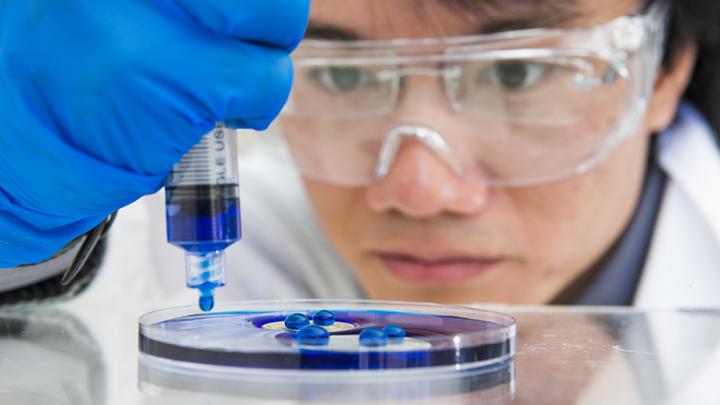
[Image above] Scientists at the Australian National University have developed a new spray-on material with a remarkable ability to repel water. Credit: Stuart Hay; ANU
One way to make materials and structures stand up better to environmental stress or chemical exposure is to engineer them from the outset to be resistant to these types of corrosive atmospheres.
But what about preserving and protecting existing materials and structures?
Enter: cutting-edge coatings.
From ice removal to water repelling to ultraviolet protection, coatings enable our vehicles to shed ice buildup, protect our structures from water damage, and keep our buildings cooler.
Protective coatings can help break the ice. Researchers at Rice University (Houston, Texas) developed a conductive graphene coating that offers a new tunable solution for surface ice shedding on aircraft, wind turbines, transmission lines, and other surfaces exposed to winter weather.
They can help keep it cool. A team of scientists from Johns Hopkins Applied Physics Laboratory (Laurel, Md.) created a glass-based paint that reflects light off metal surfaces to keep them cool and protects those surfaces from corrosion accelerated by the harsh rays of the sun.
Or they can have it made in the shade. A group of researchers at the Georgia Institute of Technology in Atlanta have developed a polymer coating for glass that can change the tint color instantly with a small, user-controlled electrical current—an innovation that could lead to major energy-saving potential for windows on buildings exposed to sunlight.
But when it comes to waterproofing, scientists at the Australian National University (ANU) say they’ve developed a new spray-on coating with a remarkable ability to repel water. And this new protective coating could eventually be used to waterproof cell phones, prevent ice formation on airplanes, and protect boat hulls against corrosion.
According to a university press release, this superhydrophobic coating is more robust than previous materials thanks to a novel combination of two plastics, one tough and one flexible.
“The surface is a layer of nanoparticles, which water slides off as if it’s on a hot barbecue,” explains William Wong, a Ph.D. student from the Nanotechnology Research Laboratory at the ANU Research School of Engineering. “It’s like two interwoven fishing nets, made of different materials.”
Credit: ANU TV; YouTube
The process to create the coating is relatively simple and more cost-efficient than what it takes to manufacture comparable coatings, the team says. To achieve this, the team developed two ways of creating the material.
“One method uses a flame to generate the nanoparticle constituents of the material. For lower temperature applications, the team dissolved the two components in a ‘sprayable’ form,” the release explains.
Plus, this water-repellent coating is also transparent and extremely resistant to ultraviolet radiation—key game-changing features of this type of material, says Antonio Tricoli, lead researcher and head of the ANU Nanotechnology Research Laboratory.
“The key innovation is that this transparent coating is able to stabilize very fragile nanomaterials resulting in ultra-durable nano-textures with numerous real-world applications,” explains Tricoli. “A lot of the functional coatings today are very weak, but we will be able to apply the same principles to make robust coatings that are, for example, anti-corrosive, self-cleaning, or oil-repellent.”
The research, published in ACS Applied Materials and Interfaces, is “Ultra-durable and transparent self-cleaning surfaces by large-scale self-assembly of hierarchical interpenetrated polymer networks” (DOI: 10.1021/acsami.6b03414).
